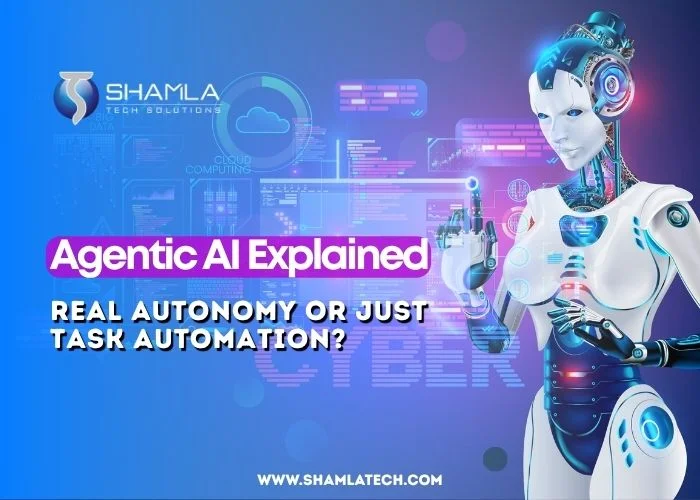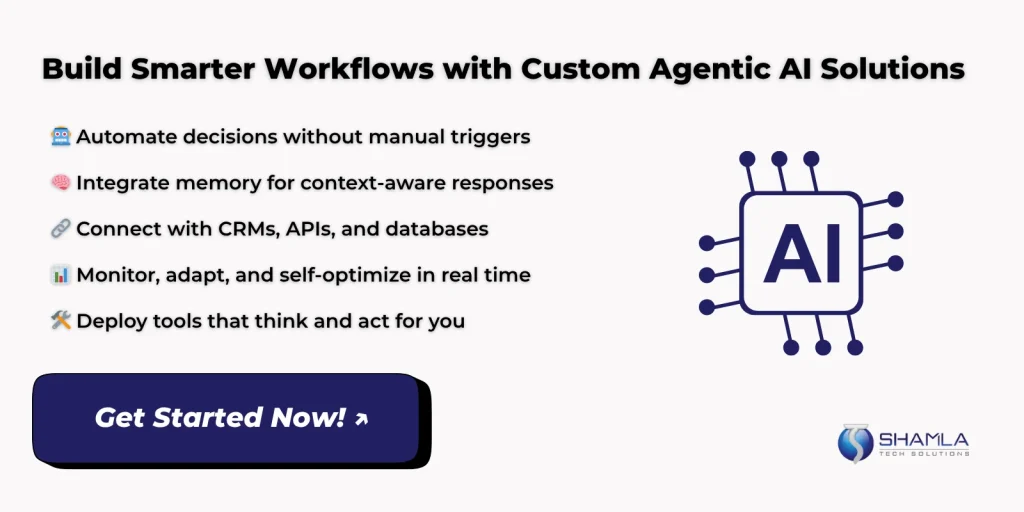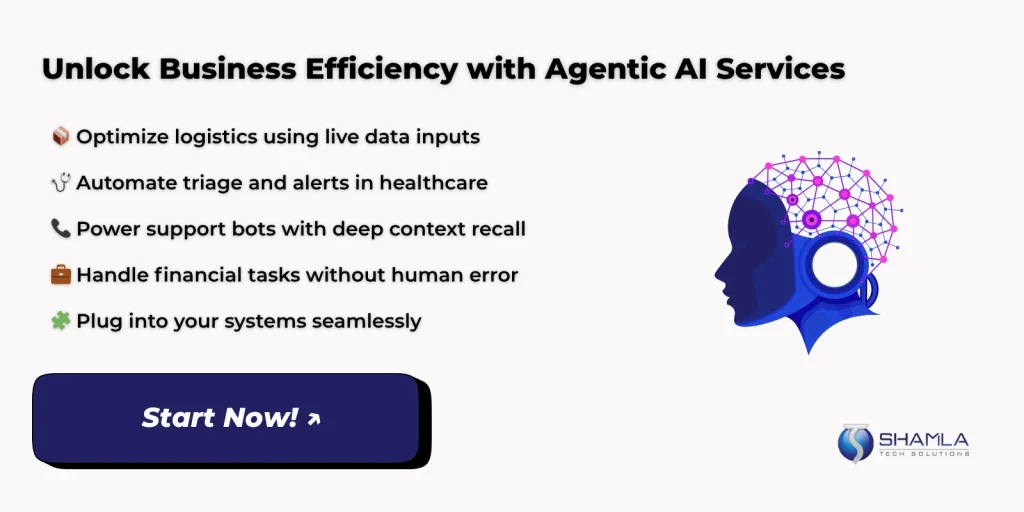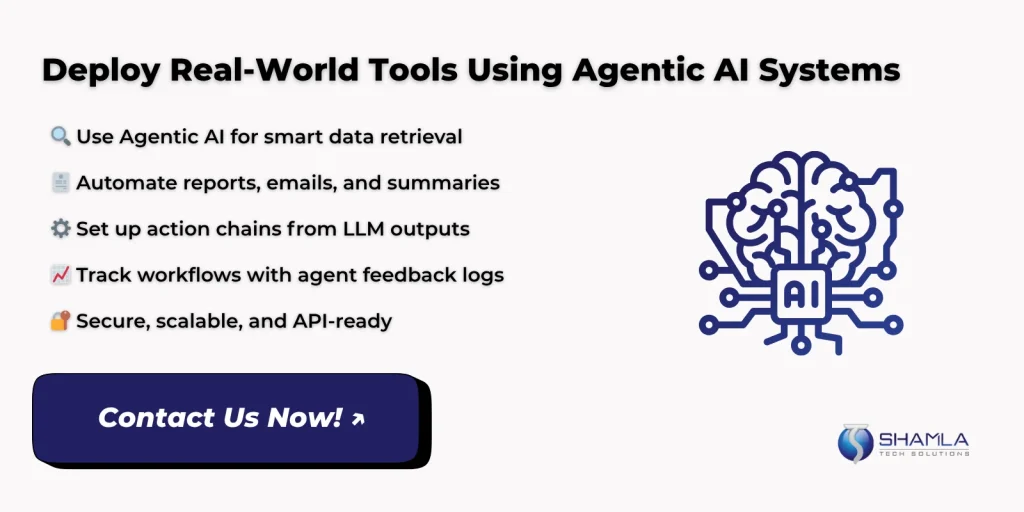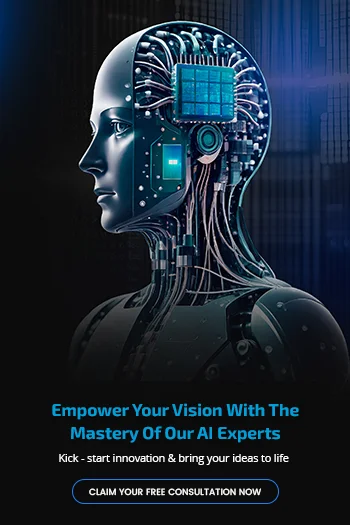Agentic AI refers to systems capable of independently making decisions, taking actions, and self-correcting without ongoing human intervention. Unlike traditional AI, which follows fixed rules, agentic AI works more like a human assistant – it can plan, act, and learn from what happens.
Today, businesses are turning to agentic AI development companies to build these advanced tools that can think and work on their own. Agentic AI development services include designing models that use memory, planning, and feedback to finish tasks across different industries. This shift is changing how businesses work, letting software run entire processes with better speed and fewer errors.
What Is Agentic AI? Breaking Down the Basics
Agentic AI describes systems that autonomously plan, make decisions, and adapt based on outcomes, requiring little human involvement. These models combine memory modules, dynamic goal setting, and continuous feedback loops to execute diverse tasks with precision. Many firms collaborate with an agentic AI development company to design and integrate robust agents that automate complex operations while remaining adaptable. Core techniques include reinforcement learning, modular architectures, and real-time context analysis. By embracing agentic AI, organizations reduce manual errors, accelerate decision cycles, and optimize resource allocation across finance, healthcare, logistics, and manufacturing. This move toward intelligent autonomy reshapes workflows into efficient, self-improving systems.
Key Aspects of Agentic AI
1. Definition and Core Features
Agentic AI is made of parts that plan actions, execute them, and learn from results without manual help. These agents keep past steps in memory buffers, use planners that focus on goals to map out action steps, and use evaluators to check results. Unlike rules, they try new actions guided by reward signals to improve over time. Key parts include neural policy networks, breaking tasks into smaller steps, constant performance monitoring, and adaptive parameter tuning. These parts let agentic AI handle changing situations, fix itself after mistakes, adjust quickly, and reach complex goals on its own, creating a base for self-running software agents.
2. Comparing Traditional Agents and Agentic AI
Traditional AI agents often follow predefined scripts or rule sets, executing tasks within narrow boundaries. In contrast, agentic AI integrates planning modules and learning loops, enabling autonomous decision making in unforeseen scenarios. While legacy agents require manual rule updates, agentic AI refines its policies through trial and error, leveraging reinforcement signals and continuous reward optimization. Conventional models process inputs and yield outputs deterministically, but agentic AI agents maintain internal state representations, adjust strategies dynamically, and manage resources autonomously. This fundamental shift transforms rigid automation into flexible autonomy, unlocking applications where systems must navigate uncertainty, optimize goals, and self‑correct without explicit instructions at every juncture.
3. Autonomy vs Automation
Automation executes predefined tasks repetitively based on explicit rules, whereas autonomy involves dynamic decision making and self‑guidance. An agentic AI development company designs architectures that blend automated routines with adaptive algorithms, empowering software to adjust parameters, select new actions, and learn from errors. Automated scripts excel at predictable workflows but fail when conditions change; true autonomy demands situational awareness, goal‑setting capabilities, and real‑time feedback integration through runtime diagnostics. By contrast, automation delivers consistency under fixed conditions but lacks flexibility. Autonomy elevates this by equipping agents with the capacity to modify behavior dynamically, refine objectives continuously, and pursue missions independently, bridging the gap between static operations and intelligent execution.
4. Significance in Modern AI Ecosystems
Companies need tools that grow with them. Agentic AI tools find use in areas like banking, hospitals, and moving goods by helping plan resources early and test situations. These tools cover every step, from setting targets to running tasks on their own and showing data. Top vendors offer AI packages with model building, fitting into existing systems, nonstop checks, and fixes. Firms pick these packages to make decisions faster, cut down on manual work, and keep getting better by tracking core success measures. Adding agentic AI tools opens up smoother operations, speeds up launches, and keeps firms ahead by using systems that study results, change on the fly, and work on their own as needs change.
Agentic AI in Action: Real-World Use Cases
1. Industrial Automation: Self-Managed Assembly Lines
In industrial automation, autonomous agents enable task management on assembly lines. Systems interpret sensor input, plan adjustments, and execute maintenance with minimal human oversight. Integration with PLC networks and edge computing nodes ensures low-latency responses for real-time quality control. Custom feedback loops monitor torque and vibration metrics, triggering dynamic speed control to prevent defects. These frameworks rely on agentic AI development services that configure reinforcement learning modules and optimize neural policy functions. By employing data pipelines and modular software containers, firms reduce deployment time and simplify upgrades. This approach cuts error rates and maximizes throughput without sacrificing safety protocols.
2. Logistics: Real-Time Freight Routing Optimization
In logistics networks, agentic AI directs freight routing to cut transit times. The system ingests traffic patterns, warehouse capacity data, and delivery deadlines to generate optimal path plans. A modular microservice handles geospatial analytics and dynamic scheduling, while real-time API feeds adjust routes for weather or congestion disruptions. Developers use containerized modules on Kubernetes clusters to achieve high availability and resilience against failures. Companies adopt agentic AI solutions to integrate predictive models with their transport management systems seamlessly. Lightweight REST APIs allow for seamless integration with dashboards. This streamlined setup reduces fuel costs and accelerates delivery cycles without adding manual planning overhead.
3. Healthcare: Automated Patient Triage and Scheduling
In healthcare, agentic AI automates patient triage by analyzing vital sign streams and electronic records. Algorithms extract heart rate, blood pressure, and lab results to score risk levels, then schedule tests or referrals automatically. A serverless function triggers alerts when parameters exceed thresholds, and integrated OAuth modules secure data access. Hospitals use agentic AI services to deploy these processes on cloud platforms, leveraging autoscaling and region failover. An audit trail logs each decision step to ensure compliance with regulations. By reducing manual review load, clinicians focus on treatment rather than paperwork. The system adapts to new protocols through secure updates.
4. Cybersecurity: Real-Time Threat Detection and Response
In cybersecurity operations, agentic AI inspects network logs to detect anomalies in real time. Machine learning classifiers examine packet headers, traffic rates, and user behaviors to flag potential intrusions. A rule engine applies sandboxing techniques to isolate suspicious executables and record forensic snapshots. DevOps teams integrate alerting workflows via webhook endpoints, forwarding incidents to ticket systems automatically. Organizations rely on agentic AI development services to build these toolchains, combining behavior analytics libraries with threat intelligence feeds. This setup supports continuous vulnerability scanning and suggests patches. By automating investigations, security analysts focus on complex threat hunts rather than repetitive log reviews.
5. Customer Support: Intelligent Self-Resolving Bots
In customer support centers, smart bots leverage natural language modules to resolve queries without handoff. Text parsers classify intents from chat transcripts, and context managers retrieve relevant database entries. A supervisor component escalates tickets when confidence scores drop below defined thresholds. Deployment on server clusters with Docker ensures consistent performance during peak loads. Businesses adopt agentic AI solutions to link chatbots with CRM records, enabling personalized responses and follow-up actions. These systems use webhook-driven notifications to update users via email. By minimizing wait times and reducing human intervention, firms improve satisfaction rates while cutting operational costs through automated case closures.
6. Financial Services: Autonomous High-Frequency Trading
In financial services, algorithmic trading platforms employ autonomous agents to execute high-frequency orders. Data streams from market APIs feed into time-series models that predict short-term price moves. A decision engine evaluates signal strength against risk limits, then issues buy or sell instructions through FIX protocol bridges. Redundant cluster setups maintain uptime, while monitoring agents restart failed processes automatically. Developers integrate logging modules to record structured trade metadata for compliance audits. By using continuous integration pipelines with elastic resource allocation, teams push algorithm updates safely. This approach cuts execution delays and slippage, boosting returns under volatile conditions without constant manual supervision.
Task Automation vs. Real Autonomy: Where Agentic AI Stands
1. Rule-Based Automation vs. Agentic Autonomy
Traditional task automation relies on pre-set rules and scripts to execute steps in fixed workflows. In contrast, agentic AI adapts to changing inputs, reorders tasks, and makes on-the-fly choices. Rule-driven systems follow deterministic paths, while agentic frameworks use feedback loops and reward signals to develop flexible policies. Agentic AI development services layer decision modules over rule engines and adjust policy weights without manual coding. They handle unforeseen scenarios by exploring alternate action sequences. This shift reduces maintenance and boosts resilience, but true autonomy remains limited by model fidelity and environment assumptions.
2. Decision Depth and Context Awareness
Rule-based automation holds no memory beyond current step definitions, so it cannot adapt when context shifts. Agentic AI embeds transient state variables and episodic traces to track progress across tasks. These state tokens inform decision pipelines, allowing agents to reference recent events and adjust policies. While rule engines match patterns, agentic systems compute utility estimates and select actions via policy networks. Agentic AI development services tune these networks with simulation data and human feedback. This grants limited situational awareness, yet still falls short of persistent memory required for complex autonomy.
3. Error Handling and Hallucination Risks
Traditional automation fails silently or throws exceptions when inputs diverge. Agentic AI systems may hallucinate, produce outputs that diverge from reality, due to overgeneralized pattern matching. Hallucination incidents arise when reward models optimize proxies rather than ground truth. To combat this, development teams enforce guardrails via fact‑check modules and confidence thresholds. They integrate verifiers and external databases to validate outputs before execution. Ongoing auditing pipelines track metric shifts in real time. These checks reduce false positives but cannot eliminate hallucinations. Teams retrain models and refine reward functions regularly in production.
4. Memory and Context Retention Limits
Agentic AI systems store short‑term context in tokens or state buffers, then discard it after task completion. They lack persistent memory across sessions, so they cannot recall past interactions reliably. Rule‑based automation has no memory at all, so both struggle with long‑run dependencies. Some agentic AI services integrate external memory stores, like vector databases, to layer retrieval functions. These hybrid setups restore context by fetching embeddings, but latency and consistency issues arise. Until we build safe lifelong memory modules, agentic tools remain confined to isolated tasks without true autobiographical recall.
5. Safety Controls and Risk Mitigation
As autonomy grows, unintended actions pose safety risks. Rule‑based pipelines halt when anomalies appear, but agentic AI may continue executing flawed plans. Safety frameworks insert kill‑switches and validate actions in sandbox environments before live execution. Agentic AI development services implement circuit breakers through overrides and tiers. They simulate adversarial scenarios to assess failure modes and refine safety rules. Continuous monitoring agents track metric anomalies and trigger alerts. This layered approach reduces harmful outcomes but cannot foresee novel threats. Real‑world deployments require human‑in‑the‑loop to catch edge‑case failures beyond automated safety nets
6. Agentic AI Development Services: Core Approaches
Agentic AI development services start by mapping environment dynamics and defining action spaces. They create modular simulators to generate synthetic data and stress‑test agent policies. Developers integrate reinforcement learning loops with human‑in‑the‑loop feedback to shape reward signals. They instrument agents with telemetry for logging and embed dynamic adapters to adjust exploration rates. These services package policies into microservices with interfaces, enabling plug‑and‑play deployment. API‑driven pipelines handle versioning and rollback. By combining simulation, feedback loops, and containerized delivery, these services tackle mismatch issues and curb drift in agent behaviors over time.
7. Evolving Boundaries: Real-World Agentic AI Services
Agentic AI services now push limits by integrating multi‑agent orchestration and chained reasoning. They implement planning chains where output from one agent feeds input to another, forming workflows. These workflows link vision, language, and control modules to accomplish complex tasks end‑to‑end. Developers leverage open standards like gRPC and Webhooks to connect agents seamlessly. They test behavior in isolated sandboxes and tune inter‑agent protocols. This architecture shifts agentic AI solutions beyond static task scripts, but it still hinges on predefined interfaces and monitoring. True agency awaits robust self‑governance frameworks and scalability.
Building Agentic AI Systems: How Development Works
1. Core Components: LLM, Memory, Tools, and Planner
A core agentic AI system relies on large language models for text understanding and generation, a memory module for context storage, tool interfaces for external calls, and a planning engine for action sequencing. LLMs process prompts and return structured outputs. The memory unit caches recent events as simple vectors. Tool interfaces expose APIs like search, database, and computation. The planner maps output actions into ordered steps. This modular design underpins agentic AI solutions in real environments. It scales linearly, efficiently.
2. Memory Modules and Context Recall
Systems embed a memory layer that holds short-term context as simple token lists or vectors. A retrieval function fetches relevant snippets when needed. This memory buffer supports coherent multi-step dialogs and actions. Agentic AI development uses vector stores and fast search to rebuild context between calls. During training, it uses stored past experiences to improve decision-making. This setup avoids context loss and reduces task failures. The system applies filters to manage buffer size and keep responses focused.
3. Tool Interfaces and External APIs
Agentic AI services create adapters for external tools through REST, gRPC, or WebSocket endpoints. Each adapter wraps functions like search, file storage, or computation into simple calls. The agent triggers these tools based on parsed output commands. Developers set rate limits and error handlers to prevent failures. These bridges let the agent perform complex tasks without manual scripts. This pluggable model speeds up integration with existing software stacks easily.
4. Planning Engine and Action Sequencing
Agentic AI planning engine breaks goals into ordered steps using simple algorithms like breadth-first or greedy search. It translates LLM outputs into actionable tasks. The planner evaluates predicted outcomes and adjusts step order. Agentic AI solutions embed this component to handle multi-stage workflows automatically. Developers tune threshold values to balance exploration and speed. The system logs each decision and updates the plan if conditions change. This dynamic sequencing avoids rigid script paths and improves task success rates under varied scenarios reliably.
5. Human Feedback and Self-Evaluation
Agentic AI agents run internal checks comparing outputs to rules and ratings. Agents compute confidence scores for each action and flag low-score steps. Agentic AI development services implement feedback loops by blending human ratings with automated tests in CI pipelines. Reviewers refine reward models and reduce errors through rated outputs. This cycle drives gradual model updates and steers behavior away from unsafe paths. Teams monitor drift and retrain agents when performance drops. This process ensures steady quality and goal alignment.
6. Integration and Importance of Expert Teams
Agentic AI modules plug into business systems via REST streams, linking CRM, ERP, and analytics tools. Adapters transform records into agent-ready formats. Agents update dashboards and trigger alerts on rule breaches. Hiring an agentic AI development company ensures experts configure secure pipelines, manage backups, and handle scale. Such a firm brings best practices, toolchain know-how, and version control. This partnership lets agents run reliably and keeps teams focused on core goals. These agentic AI services handle maintenance and future upgrades.
Conclusion
Agentic AI tools speed work by handling tasks with minimal setup. They use smart planning, memory buffers, external tool calls, and feedback loops to boost output. Businesses see lower error rates and faster operations. Agentic AI development company offers this via agentic AI solutions that drive gains, making it ideal.
Shamla Tech is an agentic AI development company offering tailored agentic AI solutions for finance, healthcare, retail, and logistics sectors. We build end-to-end systems with planning modules, memory stores, and tool interfaces. Partner with us to create custom tools that run tasks on their own and boost your business success.
Ready to build your agentic AI system? Contact us today to get started!

